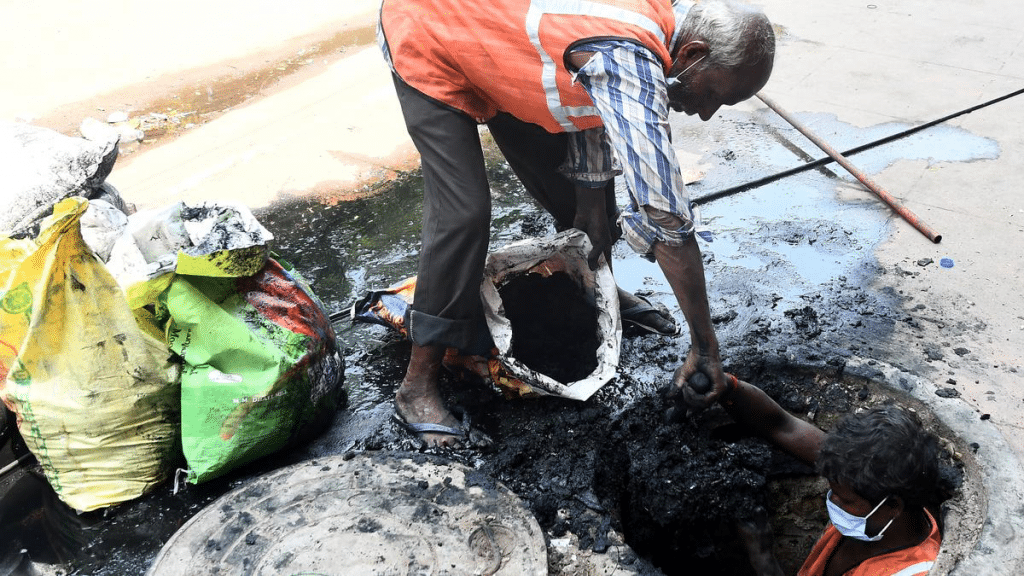Theme: Protection of vulnerable sections of the society; Government Policies and Interventions;
Source: The Hindu
Why in news: The Supreme Court has directed the government to place on record within six weeks the steps taken by it to implement its nearly 10-year-old judgment to end manual scavenging and prevent future generations from the “inhuman practice”
What is Manual Scavenging?
- Manual scavenging is the practice of removing human excreta by hand from sewers or septic tanks.
- India banned the practice under the Prohibition of Employment as Manual Scavengers and their Rehabilitation Act, 2013 (PEMSR).
- In 2013, the definition of manual scavengers was also broadened to include people employed to clean septic tanks, ditches, or railway tracks.
- The Act recognizes manual scavenging as a “dehumanizing practice,” and cites a need to “correct the historical injustice and indignity suffered by the manual scavengers.”

Data related to Manual Scavenging:
- According to Socio Economic Caste Census 2011, 1.8 lakh households are engaged in manual scavenging for a livelihood.
- The 2011 Census of India found 7.9 lakh cases of manual scavenging across India.
What are the reasons for the prevalence of Manual Scavenging?
- Inefficient Sewage Management System:
- In India, most municipalities do not have the latest machines for cleaning the sewage systems and thus sewage workers are required to enter the underground sewerage lines through manholes.
- The unskilled labourers, meanwhile, are much cheaper to hire and contractors illegally employ them at a daily wage.
- Lack of enforcement of the Act:
- The provision of the 1993 Act was not implemented effectively. Government programmes have majorly emphasised the financial aspect of rehabilitation and failed to address the caste-based oppression and action on the culprit.
- Lack of Social Mobility:
- Due to lack of basic amenities, education, and employment opportunities, manual scavengers are compelled to their job, and even society does not accept them for community activities.
- Caste based division of labour:
- Manual scavengers are usually from caste groups customarily relegated to the bottom of the caste hierarchy and confined to livelihood tasks viewed as deplorable or deemed too menial by higher caste groups
What are the effects of Manual Scavenging?
- Social Discrimination:
- Most manual scavengers are stigmatised by the community due to the nature of their job.
- They are regarded as untouchable and they are forced to accept their condition.
- Caste Based Inequalities:
- The caste is still regarded as a lower class and is excluded from moving to a better occupation.
- As a result, the scavenging work is seen as part of their natural occupation.
- Health Problems:
- The scavengers are exposed to gases such as carbon dioxide, ammonia and methane.
- Long exposure to these gases may lead to serious health diseases or even death.
- According to the Ministry of Social Justice and Empowerment on July 26, 2022 in the Lok Sabha, 966 people have been reported dead.
What are the steps taken to tackle the menace of Manual Scavenging?
Constitutional Safeguards
- The Right to Live with Dignity is implicit in the Fundamental Rights guaranteed in Part III of the Constitution.
- Article 46 of the Constitution provides that the State shall protect the weaker sections particularly, the Scheduled Castes and the Scheduled Tribes from social injustice and all forms of exploitation.
Legislative Provisions:
- Prevention of Atrocities Act 1989:
- It became an important landmark to free manual scavengers from designated traditional occupations.
- The Employment of Manual Scavengers and Construction of Dry Latrines (Prohibition) Act 1993:
- It set imprisonment of up to one year and a fine of Rs 2,000 for pushing a person to manual scavenging.
- The Building and Maintenance of Insanitary Latrines Act of 2013:
- It outlaws’ construction or maintenance of unsanitary toilets, and the hiring of anybody for their manual scavenging, as well as of hazardous cleaning of sewers and septic tanks.
- It also provides a constitutional responsibility to provide alternative jobs and other assistance to manual scavenging communities, as reparation for historical injustice and indignity.
- The Prohibition of Employment as Manual Scavengers and their Rehabilitation Act, 2013:
- The Act bans the use of any individual for manually cleaning, carrying, disposing of or otherwise handling in any manner, human excreta till its disposal.
Commission:
The National Commission for Safai Karamcharis (NCSK):
- It was established as a statutory body on August 12, 1994, by an Act of Parliament through the ‘National Commission for Safai Karamcharis Act, 1993.
- It recommends to the Central Government specific programmes of action towards elimination of inequalities in status, facilities and opportunities for Safai Karamcharis.
Other Initiatives:
- Safaimitra Suraksha Challenge:
- It was launched by the Ministry of Housing and Urban Affairs on World Toilet Day (19th November) in 2020.
- ‘Swachhta Abhiyan App’:
- It has been developed to identify and geotag the data of insanitary latrines and manual scavengers so that the insanitary latrines can be replaced with sanitary latrines and rehabilitate all the manual scavengers to provide dignity of life to them.
- National Action Plan for Mechanised Sanitation Ecosystem (NAMASTE):
- The NAMASTE scheme is being undertaken jointly by the Ministry of Housing and Urban Affairs and the MoSJ&E and aims to eradicate unsafe sewer and septic tank cleaning practices
What is the Supreme Court’s Direction?
Safai Karamchari Andolan v. Union of India 2014:
- The Supreme Court ruled that “entering sewer lines without safety gears should be made a crime even in emergency situations,” and ordered for compensation in cases of death of the worker.
- It is mandatory for the government to identify all those who died in sewage work since 1993 and provide Rs. 10 lakh each as compensation to their families.
Way forward:
Proper Identification:
- State governments should therefore identify the workers who clean toxic sludge on a priority basis to ensure effective policy implementation.
Involving all stakeholders:
- In order to tackle the problem, it would be necessary to involve all the major skate holders involved.
- The inclusion of the community around the areas that are most affected into the program is very important.
Rehabilitation and Reintegration:
- Creation of more employment is one of the most important rehabilitation processes.
- The jobs created would aim to offer equal opportunities to the locals.
- The jobs created also act as a means to assimilate manual scavengers into the community.
Creating Awareness:
- It is important to educate the community on the devastating effects caused by dry toilets.
- Government officials should inform on the legal implications that are related to engaging in scavenging and having dry toilets.
- The sanitation workers should be informed about their rights and the laws that protect them from abuse by their employers.
Investing in Proper Human Waste Management:
- Solving solid and liquid waste segregation problems, as well as bio composting at Municipal level, are some of the ways through which we can utilise waste for the benefit of humanity.
Static part to be referred: Manual Scavenging; Related initiatives; Supreme Court; National Commission for Safai Karamcharis;
Practice Mains Question:
| What is manual scavenging, and why is it still prevalent in India? Discuss the various steps to tackle it? (250 words, 15 marks) |





